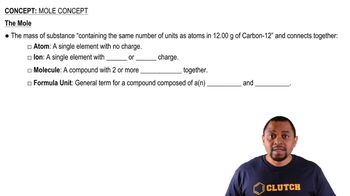The molecular formula of aspartame, the artificial sweetener marketed as NutraSweet®, is C14H18N2O5. (c) How many molecules of aspartame are present in 1.00 mg of aspartame?
Ch.3 - Chemical Reactions and Reaction Stoichiometry
Chapter 3, Problem 41c
A sample of glucose, C6H12O6, contains 1.250×1021 carbon atoms. (c) How many moles of glucose does it contain?
 Verified step by step guidance
Verified step by step guidance1
Determine the number of moles of carbon atoms using Avogadro's number. Avogadro's number is 6.022 \times 10^{23} atoms/mol.
Calculate the moles of carbon atoms by dividing the given number of carbon atoms (1.250 \times 10^{21}) by Avogadro's number.
Recognize that each molecule of glucose (C_6H_{12}O_6) contains 6 carbon atoms.
Calculate the moles of glucose by dividing the moles of carbon atoms by 6, since there are 6 carbon atoms per molecule of glucose.
Conclude with the moles of glucose calculated from the moles of carbon atoms.

Verified video answer for a similar problem:
This video solution was recommended by our tutors as helpful for the problem above.
Video duration:
1mWas this helpful?
Key Concepts
Here are the essential concepts you must grasp in order to answer the question correctly.
Mole Concept
The mole is a fundamental unit in chemistry that quantifies the amount of substance. One mole contains approximately 6.022 x 10²³ entities, such as atoms or molecules. This concept allows chemists to convert between the mass of a substance and the number of particles it contains, facilitating calculations in stoichiometry.
Recommended video:
Guided course

Mole Concept
Avogadro's Number
Avogadro's number, 6.022 x 10²³, is the number of atoms, molecules, or particles in one mole of a substance. It serves as a bridge between the macroscopic scale of substances we can measure and the microscopic scale of atoms and molecules. Understanding this number is crucial for converting between moles and the number of particles.
Recommended video:
Guided course

Avogadro's Law
Molar Mass
Molar mass is the mass of one mole of a substance, typically expressed in grams per mole (g/mol). For glucose (C₆H₁₂O₆), the molar mass can be calculated by summing the atomic masses of its constituent elements. Knowing the molar mass is essential for converting between grams and moles, which is necessary for solving problems involving quantities of substances.
Recommended video:
Guided course

Molar Mass Concept
Related Practice
Textbook Question
Textbook Question
The molecular formula of aspartame, the artificial sweetener marketed as NutraSweet®, is C14H18N2O5. (d) How many hydrogen atoms are present in 1.00 mg of aspartame?
Textbook Question
A sample of the male sex hormone testosterone, C19H28O2, contains 3.88×1021 hydrogen atoms. (b) How many molecules of testosterone does it contain?
Textbook Question
A sample of the male sex hormone testosterone, C19H28O2, contains 3.88×1021 hydrogen atoms. (c) How many moles of testosterone does it contain? (d) What is the mass of this sample in grams?
Textbook Question
The allowable concentration level of vinyl chloride, C2H3Cl, in the atmosphere in a chemical plant is 2.0×10−6 g/L. How many moles of vinyl chloride in each liter does this represent?
